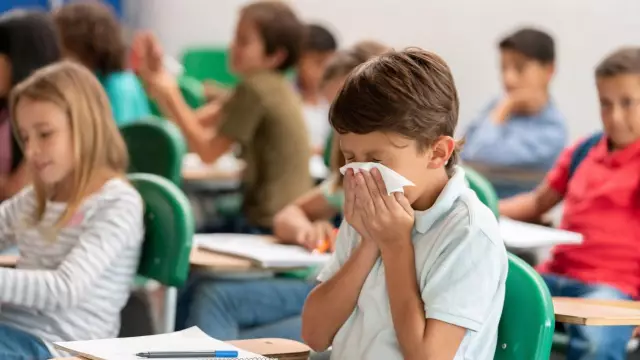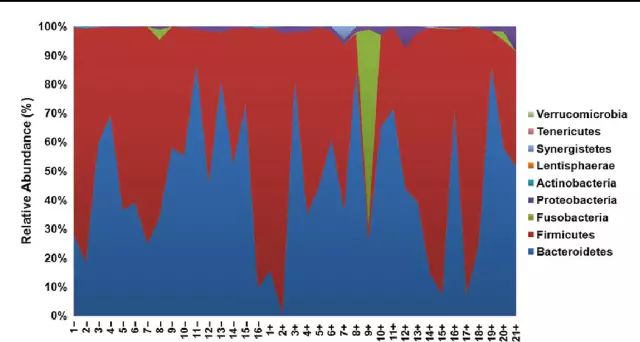- Author Rachel Wainwright [email protected].
- Public 2023-12-15 07:39.
- Last modified 2025-11-02 20:14.
Intestinal infection in children
The content of the article:
- Causes
- Forms of intestinal infection in children
- Symptoms of intestinal infection in children
- Diagnosis of intestinal infection in children
- Treatment of intestinal infections in children
- Complications of intestinal infections in children
- Forecast
- Prevention of intestinal infections in children
Intestinal infection in children is a group of diseases of various etiology, occurring with a predominant lesion of the digestive tract, a toxic reaction and dehydration of the body.

The susceptibility to intestinal infection in children is several times higher than in adults, the disease is characterized by pronounced clinical signs, may be accompanied by a weakening of immunity, the development of enzyme deficiency, and intestinal dysbiosis. Intestinal infections in children rank second in the structure of infectious morbidity after acute respiratory viral infections. The widespread prevalence of intestinal infections among children is caused by the high contagiousness and prevalence of pathogens, their resistance to environmental factors, age-related features of the structure and functioning of the digestive system, functional imperfection of protective mechanisms, as well as insufficiently vaccinated and fixed hygiene skills.
In the world, about 2 million deaths from acute intestinal infections are recorded annually, mainly among children under 5 years of age.
Causes
The causative agents of intestinal infections in children can be:
- bacteria (Shigella, Salmonella, diarrheogenic Escherichia, Yersinia, Campylobacter, Staphylococcus, Klebsiella, etc.) and their toxins (botulinum toxin);
- viruses (roto-, adeno-, entero-, astro-, corono-, toro-, caliciviruses, etc.);
- protozoa (lamblia, cryptosporidium, amoeba, blastocyst, etc.).
The penetration of infection into the body with intestinal infections occurs mainly through the use of infected food (by alimentary route), contaminated water (by water), through contaminated hands, dishes, toys, household items (by contact and household). Intestinal infections of viral etiology can also be transmitted by aerogenic (airborne droplets). Viruses cause the largest number of cases of intestinal infections in children under 5 years of age.
In children with weakened immunity, endogenous infection with opportunistic microflora (staphylococcus, Klebsiella, Proteus, Clostridium, etc.) is possible.
Forms of intestinal infection in children
Intestinal infections are classified by origin:
- bacterial (dysentery, salmonellosis, cholera, botulism, staphylococcal food poisoning, yersiniosis, typhoid fever, escherichiosis, etc.);
- viral (rotavirus, adenovirus, enterovirus, reovirus, coronavirus, etc.);
- protozoal (giardiasis, balantidiasis, amebiasis, etc.).
Until the results of laboratory tests are obtained, the disease is classified according to the localization of the pathological process (colitis, enterocolitis, gastritis, gastroenteritis, enteritis, gastroenterocolitis). In addition to localized forms of infection, children may develop generalized forms with the spread of pathogens outside the intestinal tract.
Depending on the mechanism of development, the ability to invade and the presence of similar pathogenic factors, the following types of intestinal infections are distinguished:
- invasive;
- secretory;
- osmotic;
- mixed.
The pathogenesis of invasive intestinal infections is based on the inflammatory process in the digestive tract. Pathogens (salmonella, shigella, campylobacter, enteroinvasive escherichia) penetrate into epithelial cells, causing inflammation of the mucous membrane, accumulation of endogenous toxic substances, and disruption of homeostasis.
The pathogenesis of non-invasive (secretory) intestinal infections is based on impaired reabsorption of water and electrolytes and increased secretory activity of the epithelium of the small intestine. The causative agents of secretory intestinal infections can be enterotoxigenic escherichia, enteropathogenic escherichia, cholera vibrio.

Source: hemltd.ru
The basis for the appearance of intestinal infections of the osmotic type is disaccharidase deficiency, fermentation and dehydration due to impaired absorption of water and electrolytes in the intestine. As a rule, they have a viral etiology.
According to the peculiarities of the symptoms, the course of intestinal infection in children can be typical and atypical.
Taking into account the degree of damage to the gastrointestinal tract, intoxication and dehydration, typical intestinal infections occur in mild, moderate and severe forms, and atypical ones - in erased and hypertoxic.
Depending on the duration of the course, intestinal infection can be:
- acute (up to 1.5 months);
- protracted (over 1.5 months);
- chronic (over 5-6 months).
Symptoms of intestinal infection in children
Clinical symptoms of intestinal infections in children are associated with the destruction of intestinal mucosa cells, as well as indigestion and are manifested by two syndromes: intestinal and infectious-toxic (general intoxication syndrome).
The main symptom of any form of intestinal infection is diarrhea (repeated loose stools).
Other signs:
- nausea, vomiting;
- lethargy, weakness;
- loss of appetite;
- increased body temperature;
- pain, rumbling in the stomach;
- admixture of blood in the feces;
- breathing disorders;
- decrease in body weight.
The danger is dehydration, which develops due to the loss of fluid with abundant vomit and feces. Its signs:
- sunken fontanelle in an infant;
- dry skin and mucous membranes;
- decreased urine output;
- increased thirst;
- sunken dry eyes;
The clinical picture of some intestinal infections is peculiar.
Dysentery in children is characterized by general intoxication, fever, vomiting, dysfunction of the central nervous system, cardiovascular system and colitis syndrome (dull abdominal pain, diarrhea, presence of mucus and blood impurities in feces, spasm of the sigmoid colon, pain in the rectal region).
Rotavirus infection is highly contagious, the clinical picture is manifested by gastroenteritis, gastrointestinal tract damage is combined with catarrhal symptoms (rhinitis, hyperemia of the throat, coughing, sore throat).

Source: babyzzz.ru
The symptoms of salmonellosis depend on the form of the disease. The typical (gastrointestinal) form occurs most often and can occur in the form of gastritis, pancreatitis, enteritis, appendicitis, pyelonephritis, cholecystitis, gastroenterocolitis. The stool is liquid, copious, brownish-green in color, mixed with mucus and blood. The atypical form can be septic, typhoid-like, toxic-septic (in newborns), erased and asymptomatic.
Escherichiosis affects mainly young children who are bottle-fed. The disease has a gradual onset with the onset of diarrhea, vomiting, or regurgitation over the next three to five days. Body temperature is subfebrile or normal. Stools watery, yellow-orange in color, mixed with mucus. The symptoms of the disease increase within 3-5 days. The disease can occur in three clinical variants (cholera-like syndrome, mild enteritis arising on the background of acute respiratory infections in young children and foodborne toxicoinfection).
Staphylococcal intestinal infection in children can be primary or secondary. The course of the primary infection is characterized by diarrhea, toxicosis, and vomiting. The stool is watery, mixed with mucus, greenish tinge. With a secondary staphylococcal infection, intestinal symptoms develop against the background of the underlying disease (pneumonia, tonsillitis, purulent otitis media, staphyloderma, etc.).
Diagnosis of intestinal infection in children
Diagnosis of intestinal infections in children begins with an assessment of the epidemiological history of the disease. The source of infection (contact with the patient, family focus of the disease, food, water), the mechanism of transmission of the pathogen, the prevalence of the lesion, and the intensity of manifestation of the main clinical symptoms are determined. The accuracy of assessing the degree of dehydration of the body is of particular importance, since the severity of intestinal infection in children is largely determined by the volume of fluid loss. Hemodynamic parameters (heart rate and heart rate) are assessed.
To confirm the diagnosis, laboratory tests are used:
- bacteriological studies of feces, and in severe cases of urine and cerebrospinal fluid - in order to identify a possible bacterial pathogen;
- scatological method - allows you to clarify the localization of the process in the digestive tract;
- virological methods (ELISA, KOA, RAL) - are used to identify a possible viral pathogen;
- serological methods (RTGA, RPGA) - allow to identify and increase the titer of antibodies in the blood to determine the type of pathogen and the severity of the process.
Differential diagnosis is carried out with pancreatitis, acute appendicitis, biliary dyskinesia, lactase deficiency.
Treatment of intestinal infections in children
Identification of intestinal infection in children under five years old is the basis for hospitalization in the children's infectious diseases department of the hospital.

Complex treatment of intestinal infections in children is based on etiopathogenetic principles and provides for:
- elimination of the etiological agent (antibacterial, antiviral, antiparasitic drugs);
- removal of accumulated toxic products (sorbents, probiotics, specific antibodies and serums);
- carrying out rehydration therapy, restoration of water-electrolyte balance (glucose-salt solutions for oral and parenteral rehydration), acid-base balance, regulatory mechanisms, hemodynamics;
- restoration of intestinal functions with the help of diet therapy.
In order to prevent disseminated intravascular coagulation syndrome, the therapy regimen includes means for normalizing peripheral vascular tone, improving microcirculation, reducing platelet aggregation, reducing tissue hypoxia and acidosis.
In the acute phase of the disease, a break in nutrition (water-tea break) is prescribed until vomiting and diarrhea subsides. In children who are breastfed, breastfeeding is not stopped, with artificial feeding, a short break is prescribed. After unloading and oral rehydration therapy, dosed feeding is started. The correct organization of therapeutic nutrition is necessary, the diet should be balanced in nutritional and biologically active substances, compiled taking into account the severity of intestinal infection, the intensity and nature of intestinal dysfunctions.
The diet for intestinal infection in children requires a 30-50% reduction in the daily volume of food consumed, an increase in the frequency of feedings, and the use of mixtures enriched with protective factors. With the improvement of the child's condition, the volume of food is increased daily by 100-150 ml, fractionally distributing this amount for each feeding. Food should be mashed and easily digestible, it is forbidden to include fried and fatty foods, fruits, juices and carbonated drinks, dairy products in the diet. In the future, the age-specific diet is expanded.
The effectiveness of the complex therapy carried out is assessed by clinical criteria (relief of diarrhea, vomiting, intoxication syndrome, temperature normalization) and clinical and laboratory data (negative results in bacteriological and PCR examination, normalization of the hemogram, coprocytogram).
Complications of intestinal infections in children
In severe forms of intestinal toxicosis in children, the development of pulmonary edema, acute renal and acute heart failure is possible. Severe dehydration contributes to the development of hypovolemic, infectious-toxic shock.
With developing changes in hemostasis, there is a threat of the development of the syndrome of disseminated intravascular coagulation.
Forecast
Early detection, competent preliminary diagnosis, timely appointment of adequate therapy ensure complete recovery.
Prevention of intestinal infections in children
In order to prevent the disease, it is necessary to adhere to sanitary and hygienic standards.

Prevention of intestinal infections in children is carried out along all links of the epidemic chain:
- impact on the source of infection - early detection and timely isolation of patients, examination of contact persons, admission to children's institutions of children after intestinal infections only with a negative bacteriological test;
- interruption of transmission routes - disinfection in foci of infection, cleaning of garbage, waste, insect control, control of storage, preparation and transportation of food, supervision of water supply sources, education of sanitary and hygienic skills, adherence to personal hygiene rules;
- increasing the body's defenses - organizing a balanced diet, preventing infectious diseases.
YouTube video related to the article:

Anna Kozlova Medical journalist About the author
Education: Rostov State Medical University, specialty "General Medicine".
The information is generalized and provided for informational purposes only. At the first sign of illness, see your doctor. Self-medication is hazardous to health!






